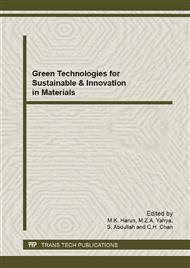[1]
Mohammed, M.A.A., et al., Gasification of oil palm empty fruit bunches: A characterization and kinetic study. Bioresource Technology, 2012. 110(0): pp.628-636.
DOI: 10.1016/j.biortech.2012.01.056
Google Scholar
[2]
Guo, J. and A.C. Lua, Effect of surface chemistry on gas-phase adsorption by activated carbon prepared from oil-palm stone with pre-impregnation. Separation and Purification Technology, 2000. 18: pp.47-55.
DOI: 10.1016/s1383-5866(99)00051-9
Google Scholar
[3]
Eduardo J. Bottani and J.M.D. Tascón, eds. Adsorption by carbons. Adsorption on activated carbon fibers, ed. A. Linares-Salano and D. Cazorla-Amoros2008, Elsevier.
Google Scholar
[4]
Carrott, P.J.M., et al., Preparation of activated carbon fibres from acrylic textile fibres. Carbon, 2001. 39(1543-1555).
DOI: 10.1016/s0008-6223(00)00271-2
Google Scholar
[5]
Alcaniz-Monge, J., et al., Effect of the activating gas on tensile strength and pore structure of pitch-based carbon fibres. Carbon, 1994. 32(7): pp.1277-1283.
DOI: 10.1016/0008-6223(94)90113-9
Google Scholar
[6]
Alcaniz-Monge, J., et al., Methane storange in activated carbon fibres. Carbon, 1997. 35(2): pp.291-297.
Google Scholar
[7]
Lee, S.M. and K. Kaneko, Preparation of ultramicroporous carbon fiber of high adsorption capacity. Carbon, 2003. 41(2): pp.374-376.
DOI: 10.1016/s0008-6223(02)00361-5
Google Scholar
[8]
Gao, F., et al., Preparation and hydrogen storage of activated rayon-based carbon fibers with high specific surface area Physics and Chemistry of Solids, 2010. 71(4): pp.444-447.
DOI: 10.1016/j.jpcs.2009.11.017
Google Scholar
[9]
Im, J.S., et al., The study of controlling pore size on eectrospun carbon nanofibers for hyrogen adsorption. Calloid and Interface Science, 2008. 318(1): pp.42-49.
Google Scholar
[10]
Derbyshire, F., et al., Synthesis of isotropic carbon fibers and activated carbon fibers from pitch precursors. Fuel, 2001. 80(3): pp.345-356.
DOI: 10.1016/s0016-2361(00)00099-5
Google Scholar
[11]
Asakura, R., et al., Preparation of fibrous activated carbons from wood fiber. Materials Science, 2004. 39(1): pp.201-206.
DOI: 10.1023/b:jmsc.0000007745.62879.74
Google Scholar
[12]
Alam, M.Z., et al., Activated carbons derived from oil palm empty-fruit bunches: Application to environmental problems. Journal of Environmental Sciences, 2007. 19(1): pp.103-108.
DOI: 10.1016/s1001-0742(07)60017-5
Google Scholar
[13]
Arami-Niya, A., et al., Production of microporous palm shell based activated carbon for methane adsorption: Modeling and optimization using response surface methodology. Chemical Engineering Research and Design, 2011(0).
DOI: 10.1016/j.cherd.2011.10.001
Google Scholar
[14]
Arami-Niya, A., W.M.A.W. Daud, and F.S. Mjalli, Comparative study of the textural characteristics of oil palm shell activated carbon produced by chemical and physical activation for methane adsorption. Chemical Engineering Research and Design, 2011. 89 (6): pp.657-664.
DOI: 10.1016/j.cherd.2010.10.003
Google Scholar
[15]
Lillo-Ródenas, M.A., et al., Activated carbons prepared by pyrolysis of mixtures of carbon precursor/alkaline hydroxide. Journal of Analytical and Applied Pyrolysis, 2007. 80(1): pp.166-174.
DOI: 10.1016/j.jaap.2007.01.014
Google Scholar
[16]
Moran, J.I., et al., Extraction of cellulose and preparation of nanocellulose from sisal fibers. . Cellulose, 2008. 15(1): pp.149-159.
DOI: 10.1007/s10570-007-9145-9
Google Scholar
[17]
Guo, J. and A.C. Lua, Characterization of adsorbent prepared from oil-palm shell by CO2 activation for removal of gaseous pollutants. Materials Letters, 2002. 55(5): pp.334-339.
DOI: 10.1016/s0167-577x(02)00388-9
Google Scholar
[18]
Yang, H., et al., Characteristics of hemicellulose, cellulose and lignin pyrolysis Fuel, 2007. 86(12-13): pp.1781-1788.
DOI: 10.1016/j.fuel.2006.12.013
Google Scholar
[19]
Stuart, B.H., Infrared Spectroscopy: Fundamentals and Applications2004, UK: John Wiley and Sons, Ltd.
Google Scholar
[20]
Bilba, K. and A. Ouensanga, Fourier transform infrared spectroscopic study of thermal degradation of sugar cane bagasse. Analytical and Applied Pyrolysis, 1996. 38(1-2): pp.61-73.
DOI: 10.1016/s0165-2370(96)00952-7
Google Scholar
[21]
Ahmad, A.L., M.M. Loh, and J.A. Aziz, Preparation and characterization of activated carbon from oil palm wood and its evaluation on Methylene blue adsorption. Dyes and Pigments, 2007. 75(2): pp.263-272.
DOI: 10.1016/j.dyepig.2006.05.034
Google Scholar
[22]
Lua, A.C. and T. Yang, Properties of pistachio-nut-shell activated carbons subjected to vacuum pyrolysis conditions. Carbon, 2004. 42(1): pp.224-226.
DOI: 10.1016/j.carbon.2003.09.013
Google Scholar
[23]
Linares-Solano, A., et al., Activated carbons from bituminous coal: effect of mineral matter content. Fuel, 2000. 79(6): pp.635-643.
DOI: 10.1016/s0016-2361(99)00184-2
Google Scholar
[24]
Linares-Solano, A. and D. Cazorla-Amoros, Adsorption on activated carbon fibers. Adsorption by carbons, 2008: pp.431-454.
DOI: 10.1016/b978-008044464-2.50021-3
Google Scholar
[25]
Valix, M., W.H. Cheung, and K. Zhang, Role of chemical pre-treatment in the development of super-high surface areas and heteroatom fixation in activated carbons prepared from bagasse. Microporous and Mesoporous Materials, 2008. 116(1-3): pp.513-523.
DOI: 10.1016/j.micromeso.2008.05.020
Google Scholar
[26]
Cuerda-Correa, E.M., et al., Preparation of activated carbons previously treated with sulfuric acid. A study of their adsorption capacity in solution. Applied Surface Science, 2006. 252(17): pp.6042-6045.
DOI: 10.1016/j.apsusc.2005.11.013
Google Scholar
[27]
Guo, J. and A.C. Luo, Characterization of adsorbent prepared from oil-palm shell by CO2 activation for removal of gaseous pollutants. Materials Letters, 2002. 55(5): pp.334-339.
DOI: 10.1016/s0167-577x(02)00388-9
Google Scholar
[28]
Shao, X., W. Wang, and X. Zhang, Experimental measurement and computer simulation of methane adsorption on activated carbon fibers. carbon, 2007. 45(1): pp.188-195.
DOI: 10.1016/j.carbon.2006.07.006
Google Scholar


